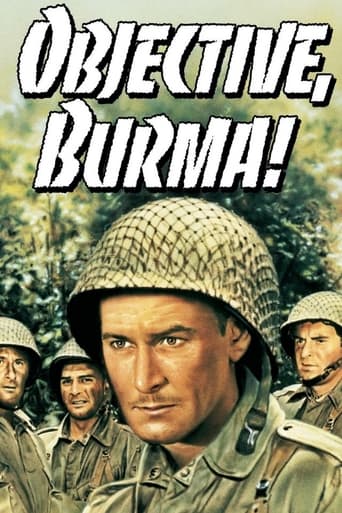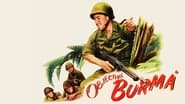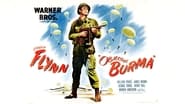mark.waltz
The war was winding down, although the majority of the world was unaware of it, when Warner Brothers gave film hoers one of the biggest, one of the quietist, and one of the longest action adventures of that period. This is a drama that other than dramatic music and exotic bird sounds features only infrequent lines of dialog once Errol Flynn and his band of merry men five out of a plane into the unknown jungles and grassy knolls of Burma, the cover for Japanese soldiers preparing their own attacks. It's amazing how they put together a script with events surrounding a shell of a story and make it entertaining. Flynn is surrounded by a cast of mostly unknown contract character players whose faces you may recognize if you've seen a bulk of Warner's output. The most recognizable is George Tobias who seemed to be in every Warner film of the time, but I found myself also recognizing Henry Hull who just happened to pop up in at least three films I've watched in the past few days. I'd like to think that what I'm seeing is at least partially based upon truth, but after getting settled in after accepting the fact that I'd be tied down with this for 2 1/2 hours, I was pretty engrossed. It's up there with "Action in the North Atlantic", " Air Force", "Destination Tokyo" and "Edge of Darkness" as films which really put Warners on the map for their output of these brilliantly produced propaganda war films that kept the homefront in tuned with what was going on with their husbands and sons overseas.
weezeralfalfa
Flynn as the leader of a secret paratrooper patrol, deep in Japanese-controlled Burmese jungle, to take out a radar station, to facilitate the success of an anticipated air offensive. First, I will note an obvious connection between this screenplay and that of the prior "Northwest Passage", which also deals with a very dangerous march by Americans, through the forested wilderness, from New England to Canada and back, 2 centuries earlier. In both films, the troopers have a distant specific objective to destroy, which they succeed in doing. However, their expected pickup by plane or provisioned safe haven doesn't materialize, leading to much depression and suffering. They face potential starvation at times on the return trip, as well as constant threat of attack. In both, on the return trip, the leader decides to split the group in two to reduce the chance of detection, the one not including the prime commander being ambushed and nearly all tortured and killed. But, in both, eventually, their deliverance is accomplished for the survivors. I rate "Northwest Passage" as somewhat more entertaining, being my favorite Spencer Tracy film, which was shot in Technicolor, rather than the B&W of the present film.In contrast to most of his prior 'period' films, Flynn plays it straight, grimy and sweaty throughout the film., based on very contemporary WWII happenings. Very unusually, there are no women in this film, hence no budding romance angle. The humor is limited to small talk and personal eccentricities, with the character actors, rather than Flynn, providing nearly all the humor. Henry Hull, as a reporter included in the mission, serves as Flynn's special confident for part of the film, until he dies of exhaustion.The use of mostly real WWII equipment and gear should be commended, most being readily available. I was not aware that gliders were used in this war theater, but consultation with a history source confirmed this. Clearly, the moderately-sized USAAF CG-4A glider was the main type used in this rescue/mass air offensive combo, it being shown delivering jeeps and small artillery, as well as troops. After WWII, advanced helicopter's would take over this role. In the parting shot, the survivors leave in one of these gliders, most of which were assumed to be damaged beyond future usefulness, after the rough landing of their maiden flight. Amazingly, their C47 puller is shown somehow hooking onto the glider towline, pulling it aloft, without landing! One wonders why gliders weren't used, instead of parachutes, in the original landing, where forest clearings were rare and small. No doubt, because a glider would be impossible to hide, whereas the parachutes were promptly buried. One character suggested that they would be jumping at a mere 300 feet altitude, to avoid some being scattered into the forest and to avoid radar detection. I didn't think this very low altitude jump was possible, but an internet source claimed some jumps during WWII were even lower! Actually, the claim that the radar installation couldn't be seen in aerial photographs nor by bomber crews, hence necessitating a paratrooper hunt, looks made up! The installation clearly looked to be in plane view from the air(pun unintended).The film includes some shots here and there clearly taken from actual combat footage, adding to the realism. However, believe it or not, all studio filming took place within the greater L.A. area, including realistic-looking tropical jungle, swamps, and rivers. During the long periods of sneaking through the dense foliage and wading across rivers, we often hear various animal sounds, most recognizably, the Australian kookaburra. Director Walsh had made many silent films, thus was good at directing the long periods with little or no conversation. Although the implication is that the Japanese were the only enemy in Burma, in fact, neighboring Thais, and troops of Burmese and Indian independence advocacy groups were also allied with the Japanese in parts of Burma. Also, although the film focuses on US operations, forces of the British Empire played the dominant role in trying to oust the Japs from this British colonial country. This includes the dramatized air armada near the film ending, which is shown as an American invasion. Thus, this film was soundly criticized in the UK and soon withdrawn from distribution there. For a period, the dominant interest of the US in Burma had been to use it as a launching pad for B29s to bomb the Japanese homeland and China-located installations. However, it was discovered that the B29 engines were prone to failure at the high altitudes over the mountains between. Eventually, captured Pacific islands provided much closer air fields for B29 bombing of Japan.This is arguably the best of Flynn's several WWII-related films made during the war, although it may be too long, with too many silent stretches of walking or waiting. It's also the only one not scripted as taking place in Europe. The prior "Desperate Journey" also involved a lengthy sojourn in enemy territory, but was partly a farce, ridiculing the Nazis.Ironically, Flynn was rejected for active service, due to several ongoing or potential health problems. During shooting, he sometimes was unable to perform, due to one health problem or another. Also, freaky summer weather often prevented shooting.
ma-cortes
Thrilling as well as exciting flick , it was partially inspired by "Operation Loincloth," a 1943 long-range operation in Burma by the British Chindits . However , members of Merrill's Marauders, who were on location as technical advisers, critiqued the fact that Nelson's men killed all the Japanese at the radar station so quickly with none wounded or escaped . In 1944, a platoon of special ops are tasked to parachute into the distant Burmese jungle and destroy a strategic Japanese radar station, but getting out isn't as easy . Capt. Charlie Nelson (Errol Flynn) is assigned a risked mission , as he leads the group of paratroopers (George Tobias , Anthony Carbone , James Brown , William Prince) into Burma to blow up an important post in advance of the allied invasion. They're accompanied on the assignment by Mark William (Henry Hull) , an American reporter who is there to write about their feats . After destroying the remote post , then the command is forced to get away and continue their exploits . The band of American soldiers must face the treacherous jungle and hostile Japanese in order to reach safety and battle against risks .Zestful Warlike action film in which a platoon suffers several dangers to wipe out Japanese station . This exciting Warlike film packs thrills , noisy action , spectacular battles and lots of gutsy adventure . Epic , sprawling , almost primitive action , teaming across the screen . Impressive images when the platoon discovers a massacre and spectacular square off in a breathtaking climax . Interesting script by writer Lester Cole, who co-wrote the somewhat overly patriotic flag-waving script, would be branded an "Un-American" Communist, becoming one of the Hollywood Ten just a few years later . However, producer Jerry Wald also admitted that much of the screenplay was based on ¨Northwest passage¨, a film about the adventures of a long-range ranger unit during the French & Indian War . Raoul Walsh demonstrates a special talent for making the densest action sequences seem uncomplicated and uncluttered and his characters , like the scenes distinguished , often have an unfettered , raw power . All the weapons, uniforms, and gear used in this movie are original and accurate ; this was possible due to the fact that these were still in use to the US military when this film was made , WW2 movies made in recent times use reproduction weapons and gear . This one results to be a top excitement flick and reworked as ¨Distant drums¨ set in the Florida Everglades , being also filmed by Raoul Walsh . Most of the exteriors of Burma were shot at the Los Angeles County Arboretum and Botanic Garden. The film has an authentic feel to it, thanks to the use of authentic military aircraft and materials . Also, the film includes a large amount of authentic footage taken by U.S. Army Signal Corps cameramen in the China Burma India theater.The motion picture lavishly produced by Jack L Warner was compellingly directed by Raoul Walsh . From his starts in the silent cinema he achieved successful films until the 50s and forward , early 60s , when he was less dominant , but is still stayed lots of lusty adventure , stories of comradeship and friendship , and Raoul makes the most of plentiful action scenes . Walsh was an expert director of all kind genres but with penchant in Western as ¨Colorado territory¨ , ¨They died with their boots on¨, ¨Along the great divide¨, ¨Saskatchewan¨, ¨King and four queens¨ , ¨The sheriff of fractured jaw¨, ¨A distant trumpet¨ ; Adventure as ¨Thief of Bagdad¨, ¨Captain Horatio Hornblower¨, ¨World in his hands¨, ¨Blackbeard the pirate¨ , ¨Sea devils¨ ; Warlike as ¨Objetive Burma¨ , ¨Northern pursuit¨, ¨Marines let's go¨ ; and Noir film as ¨White heat¨, ¨High Sierra¨, ¨They drive by night¨, ¨The roaring twenties¨. Rating : Fairly straightforward movie and better than average . This interesting Wartime film makes it of the finest of Raoul Walsh genre entries .
Steffi_P
War films made during World War Two changed distinctly as the conflict wore on. At the beginning there were idealistic flag-wavers, feature-length recruitment ads. Then there were pictures about endurance and perseverance, designed to keep everyone's spirits up. In the final year of the war, when victory was certain yet the full cost and horror of it all was known and keenly felt, war movies began to take on a dark and bitter edge. Among the darkest and bitterest of them all was Objective Burma, released just a few months before the defeat of Japan.The story of Objective Burma, which gave writer Alvah Bessie his only Oscar nomination, involves a mission deep in the jungle which goes entirely according to plan, all except for the pickup of the men to get them back to base. The situation you then have is a group of soldiers stranded in a jungle swarming with hostile Japanese. What results is an incredibly tense story in which the hope is not one of victory but simply one of survival. It really makes a great basis for an action movie, because like a good horror flick it elicits a kind of thrill through the continual sense of danger. The characters are fairly one-dimensional GI stereotypes – cheeky, earthy, working class guys – that you can see in any cheap war flick, but this in a way adds to the horrific and harrowing impact of many of the later scenes. It soon becomes pretty clear that the "Burmese dancing girls" that one of the men jokingly refers to in an early scene, are not going to make an appearance in this kind of war film.Of course, it can only work if we the audience feel immersed in that danger. This is where director Raoul Walsh comes in. Walsh was really adept at this sort of thing, and strives to constantly give us a feel of the soldiers' plight. His every shot seems composed to give us a sense of both the vastness and the oppressive closeness of the environment. Often he uses point-of-view shots, for example putting us in the position of a GI peeping out of the bushes at a passing Jap patrol. At other times he takes a god-shot, looking down on the pitiful band wending its way through the undergrowth. There's a great use of sound design, with various animal noises making eerie laughing and screeching noises. What is important too is Walsh's focus on faces. In a movie where, from a distance, every uniformed man looks alike, an occasional attention grabbing shot of some very individual expression helps to underline the sense of this as a human tragedy. As the situation becomes more and more desperate, Walsh literally darkens the screen, with the impressive James Wong Howe cinematography getting ever more shadowy.You couldn't have made Objective Burma at the height of the war. It's simply too bleak. It would be useless as recruitment propaganda. The one thing that really ties it to its era however is the vehemence it shows towards the Japanese. You really get that feeling of bitterness towards the foe in a protracted conflict, and even the kind of mindset that would start dropping nukes on cities. And then again, Operation Burma has a kind of timeless and placeless quality to it, being as it is so far removed from any kind of civilization or familiar reference point. Stripped down to a handful of men, a huge expanse of jungle and an ever-present but barely-glimpsed enemy, this is a suspenseful and exciting adventure with broad and lasting appeal.







